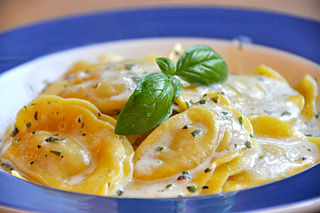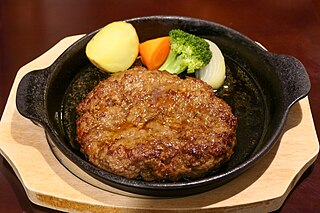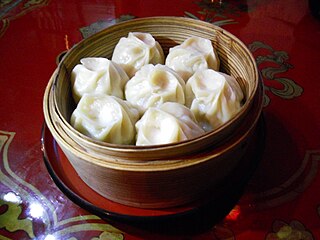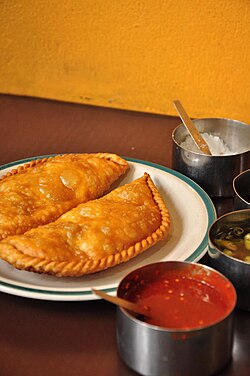
Asian food encompasses several significant regional cooking styles: Central Asian, East Asian, North Asian, South Asian, Southeast Asian, and West Asian. Cuisine is a distinctive way of cooking practices and customs, usually associated with a specific culture. Asia, as the largest and most populous continent, is home to many cultures, each with its own characteristic cuisine. Asian cuisine is considered the “culture of food within a society” due to the beliefs, cooking methods, and the specific ingredients used throughout the entire process. Asian cuisines are also renowned for their spices. A key taste factor in Asian cuisine is “umami” flavor, a strong savoriness prominent in Asian cooking, which can be achieved through fermented food or meat extract.

Ravioli are a type of stuffed pasta comprising a filling enveloped in thin pasta dough. Usually served in broth or with a sauce, they originated as a traditional food in Italian cuisine. Ravioli are commonly square, though other forms are also used, including circular and semi-circular (mezzelune).

Schnitzel is a thin slice of meat. The meat is usually thinned by pounding with a meat tenderizer. Most commonly, the meat is breaded before frying. Breaded schnitzel is popular in many countries and is made using veal, pork, chicken, mutton, beef, or turkey. Schnitzel originated as wiener schnitzel and is very similar to other breaded meat dishes.

Egg foo young is an omelette dish found in Chinese cuisine. The name comes from the Cantonese language. Egg foo young is derived from fu yung egg slices, a mainland Chinese recipe from Guangdong.

Momos are a type of steamed filled dumpling in Tibetan and Nepali cuisine that is also popular in neighbouring Bhutan and India. The majority of Tibetan momos are half-moon in shape like jiaozi, while Nepali momos are normally round like baozi. Momos are usually served with a sauce known as achar influenced by the spices and herbs used within many South Asian cuisines. It can also be cooked as soup versions known as jhol momo where the broth is made from achar using a mixture of tomatoes, sesame seeds, chillies, cumin and coriander or mokthuk from boiling pork/buffalo bones mixed with various herbs and vegetables.

Noodle soup refers to a variety of soups with noodles and other ingredients served in a light broth. Noodle soup is a common dish across East Asia, Southeast Asia and the Himalayan states of South Asia. Various types of noodles are used, such as rice noodles, wheat noodles and egg noodles.

Tibetan cuisine includes the culinary traditions and practices of the Tibetan people in the Tibet region. The cuisine reflects the Tibetan landscape of mountains and plateaus and includes influences from neighbors. It is known for its use of noodles, goat, yak, mutton, dumplings, cheese, butter, yogurt, and soups. Vegetarianism has been debated by religious practitioners since the 11th century but is not prevalent due to the difficulty of growing vegetables, and cultural traditions promoting consumption of meat.

Hamburg steak is a patty of ground beef. Made popular worldwide by migrating Germans, it became a mainstream dish around the start of the 19th century. It is related to Salisbury steaks, which also use ground beef. It is considered the origin of the hamburger, when, in the early 20th century, vendors began selling the Hamburg steak as a sandwich between bread.

Buuz are a type of Mongolian steamed dumpling filled with meat. An example of authentic Mongolian and Buryatian cuisine, the dish is traditionally eaten at home during Tsagaan Sar, the Lunar New Year. In modern times it is also offered at restaurants and small cafes ("guanz") throughout the capital city of Ulaanbaatar.

Mongolian barbecue is a stir-fried dish that was developed in Taiwan during the 1950s. Despite its name, the dish is not Mongolian and is only loosely related to barbecue.

A staple of Bhutanese cuisine is Bhutanese red rice, which is like brown rice in texture, but has a nutty taste. It is the only variety of rice that grows at high altitudes. Other staples include buckwheat and increasingly maize.

Cheburek are deep-fried turnovers with a filling of ground or minced meat and onions. A popular street dish, they are made with a single round piece of dough folded over the filling in a crescent shape. They have become widespread in the former Soviet-aligned countries of Eastern Europe in the 20th century.

Kavurma is a broad type of fried or sautéed meat dish found in Turkish cuisine. The name also refers to canned or preserved versions of a similar dish, prepared by dry frying the meat to render down the fat. Similar dishes are known in Central Asia as kuurdak. It's present in cultures and cuisines of Turkey, neighbouring countries, including the Balkans, most notably in Serbia.

Arab Indonesian cuisine is characterized by the mixture of Middle Eastern cuisine with local Indonesian-style. Arab Indonesians brought their legacy of Arab cuisine—originally from Hadhramaut, Hejaz, Sudan and Egypt—and modified some of the dishes with the addition of Indonesian ingredients. The Arabs arrived in the Nusantara archipelago to trade and spread Islam. In Java, since the 18th century AD, most of Arab traders settled on the north coast and diffuse with indigenous, thus affecting the local cuisine culture, especially in the use of goat and mutton meat as well as ghee in cooking.














